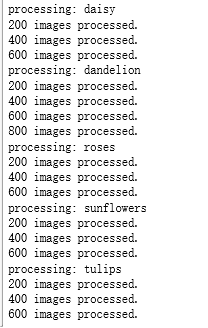import glob import os.path import numpy as np import tensorflow as tf from tensorflow.python.platform import gfile # 原始输入数据的目录,这个目录下有5个子目录,每个子目录底下保存这属于该 # 类别的所有图片。 INPUT_DATA = 'F:\TensorFlowGoogle\201806-github\datasets\flower_photos\' # 输出文件地址。我们将整理后的图片数据通过numpy的格式保存。 OUTPUT_FILE = 'F:\shuju\flower_processed_data.npy' # 测试数据和验证数据比例。 VALIDATION_PERCENTAGE = 10 TEST_PERCENTAGE = 10 # 读取数据并将数据分割成训练数据、验证数据和测试数据。 def create_image_lists(sess, testing_percentage, validation_percentage): sub_dirs = [x[0] for x in os.walk(INPUT_DATA)] is_root_dir = True # 初始化各个数据集。 training_images = [] training_labels = [] testing_images = [] testing_labels = [] validation_images = [] validation_labels = [] current_label = 0 # 读取所有的子目录。 for sub_dir in sub_dirs: if is_root_dir: is_root_dir = False continue # 获取一个子目录中所有的图片文件。 extensions = ['jpg', 'jpeg', 'JPG', 'JPEG'] file_list = [] dir_name = os.path.basename(sub_dir) for extension in extensions: file_glob = os.path.join(INPUT_DATA, dir_name, '*.' + extension) file_list.extend(glob.glob(file_glob)) if not file_list: continue print("processing:", dir_name) i = 0 # 处理图片数据。 for file_name in file_list: i += 1 # 读取并解析图片,将图片转化为299*299以方便inception-v3模型来处理。 image_raw_data = gfile.FastGFile(file_name, 'rb').read() image = tf.image.decode_jpeg(image_raw_data) if image.dtype != tf.float32: image = tf.image.convert_image_dtype(image, dtype=tf.float32) image = tf.image.resize_images(image, [299, 299]) image_value = sess.run(image) # 随机划分数据聚。 chance = np.random.randint(100) if chance < validation_percentage: validation_images.append(image_value) validation_labels.append(current_label) elif chance < (testing_percentage + validation_percentage): testing_images.append(image_value) testing_labels.append(current_label) else: training_images.append(image_value) training_labels.append(current_label) if i % 200 == 0: print(i, "images processed.") current_label += 1 # 将训练数据随机打乱以获得更好的训练效果。 state = np.random.get_state() np.random.shuffle(training_images) np.random.set_state(state) np.random.shuffle(training_labels) return np.asarray([training_images, training_labels,validation_images, validation_labels,testing_images, testing_labels]) with tf.Session() as sess: processed_data = create_image_lists(sess, TEST_PERCENTAGE, VALIDATION_PERCENTAGE) # 通过numpy格式保存处理后的数据。 np.save(OUTPUT_FILE, processed_data)
